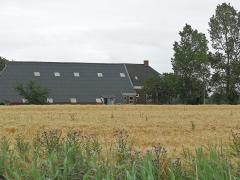Rethinking Global Biodiversity Strategies
The mere protection of valuable nature areas, although still necessary, will not be sufficient for reducing biodiversity loss. To strongly reduce the rate of global biodiversity loss in the coming decades, structural changes in consumption and production are needed. A reduction in meat consumption would be of great benefit. In addition, changes are needed especially in agriculture, forestry, fishery and in the supply of energy.
A combined approach would deliver the largest benefits
Measures aimed solely at one sector, such as that of forestry or energy, only lead to limited improvements. Implementing measures collectively would yield far greater benefits. The PBL has calculated the effect from one such combination of measures, resulting in a halving of the projected global loss of biodiversity, up to 2050. Other measures or combinations of measures are also thinkable, but none will be able to halt this loss, completely. The combination of measures as analysed by the PBL would also help to reduce climate change and increase food security.
Reason behind research
The upcoming meeting of the Conference of the Parties (COP10) of the Convention on Biological Diversity, organised by the United Nations, to be held in Nagoya, Japan, from 18 to 29 October, will discuss possible measures for substantially reducing the loss of biodiversity. At the request of the United Nations Environment Programme (UNEP), and co-financed by the Dutch Ministry of LNV, the PBL has studied several options for reducing biodiversity loss, in collaboration with the Dutch Agricultural Economics Research Institute (LEI-WUR) and the University of British Columbia, Canada. The study concentrated specifically on possible solutions that would lead to structural changes in production and consumption. The report will be presented to the Executive Director of UNEP, Mr Achim Steiner, during the COP10 meeting in Nagoya.
Growing demand for food, water and energy
The demand for food, wood, energy and clean water is projected to increase sharply, over the next 40 years. The world population is expected to grow from 6.8 to 9 billion people, and disposable incomes will also increase. Agriculture and urbanisation often compete with nature over the same land areas. Under unchanged policy, biodiversity will continue to suffer. If we keep meeting this growing demand, the amount of land used for human activity will expand enormously; not only in the supply of food but also in relation to wood supply and biofuels. This would mean a further decrease in the areas available for natural ecosystems. Biodiversity also reduces as a result of ecosystem overexploitation, disturbance and fragmentation, climate change, soil contamination, and water and air pollution.
However, biodiversity is useful and of great importance to humanity, among other things because it enhances soil fertility, manages water regulation and takes care of essential carbon uptake. In addition, many people feel that preservation of species richness and maintaining valuable nature areas are also our moral obligation.
Clever measures will limit biodiversity loss
Halting biodiversity loss altogether is hardly possible, in view of the growing global population and developing prosperity in large parts of the world. What can be done, however, is to limit the futher loss. A first step in this direction would be the protection of valuable nature areas, which, to date, has been the main policy objective. However, more is needed, and with a number of clever measures it will be possible to combine increasing production and consumption with a reduction in the loss of biodiversity:
- Animal husbandry is responsible for a relatively large part of biodiversity loss, worldwide. Therefore, a change in consumption patterns towards less meat would contribute to the preservation of biodiversity. If meat consumption were to go down, there would be less space required for animal farming; lessening the amount of food waste could lead to a similar result. This would leave more land area available to natural ecosystems.
- Modern and sustainable agricultural methods could greatly improve food production per hectare, worldwide.
- Forestry could become much more effective. The expansion of forest plantations that deliver high timber yields would lessen deforestation in areas with pristine forests. Wood production in mainly tropical natural forests could improve by reducing damage caused by selective logging.
- Sustainable fishery would lead to recovery of fish stocks and thus enable structurally larger and less perishable catches.
- Reducing deforestation aids climate change reduction. This is already incorporated into climate policy.
These measures, combined with the proven protection of specific species and ecosystems, offer the prospect of a sizeable reduction in biodiversity loss by 2050. This reduction, however, comes at a price; the above measures also generate substantial negative consequences. Achieving sustainable fishery, for example, would require years of large limitations put on catches, which, in turn, would have an enormous impact on the livelihoods of fishermen the world over. Sustainable agricultural methods demand large investments, causing higher agricultural prices. And many people enjoy eating meat; they would experience a sense of loss when having to cut down on much of their meat consumption. Incidentally, these adjustments in consumption patterns could not be enforced by government. Citizens would have to make such a choice for themselves, whereby product pricing and information about alternative options would play a role.
The PBL is not the first to indicate possible options, but a quantitative analysis of the effects of such options has not been conducted before. The analysed options also have been mentioned in many recent studies, such as the Global Biodiversity Outlook 3 of the Secretariat of the Convention on Biological Diversity (SCBD). In its analysis of the combination of options, the PBL avoided any overly extreme ambitions, and assumed development angles that seemed feasible. The researchers did not define the exact specifications of concrete measures.
Integral approach delivers the most
Separately, the described options offer only limited possibilities for combating biodiversity loss. Most address just one or some of the causes of biodiversity loss. Certain options even counter each other. In addition, options can have negative effects on other issues, such as food security. In this study, the PBL shows that a combined approach would deliver the largest benefits. The effects of a specific combination of measures have been calculated, to demonstrate their combined result. Many other combinations could also be envisioned, possibly leading to larger or smaller results than the currently calculated halving of the rate of biodiversity loss.
Biodiversity loss presents a large political and societal task, both in individual countries and internationally. Global collaboration is crucial between countries and between UN organisations such as UNEP (biodiversity), FAO and UNFF (food, forestry), IPCC and UNFCC (climate), UNDP (development), and WHO (health). As only such collaborations could achieve a global, integral approach. The Conference of the Parties (COP10) of the Convention on Biological Diversity (CBD) in Nagoya, is intended to give a push in this direction.
Information about and during COP10
During the COP10 event, the PBL will maintains a web dossier on this website.
Authors
Specifications
- Publication title
- Rethinking Global Biodiversity Strategies
- Publication subtitle
- Exploring structural changes in production and consumption to reduce biodiversity loss
- Publication date
- 5 October 2010
- Publication type
- Report
- Page count
- 172
- Publication language
- English
- Product number
- 282




